A Predictive Mimicker of Fracture Behavior in Fiber Reinforced Concrete Using Machine Learning
Abstract
:1. Introduction
- Fiber Properties: Mechanical properties, aspect ratio, and volume fraction;
- Matrix properties: Initial flaw size distribution and its mechanical properties;
- Fiber-matrix interfacial properties: Chemical and frictional bond.
2. Methodology
2.1. Machine Learning Models
2.1.1. Artificial Neural Networks (ANN)
2.1.2. Regression Analysis
2.1.3. Regression Tree Analysis
2.2. Generative Adversarial Network (GAN)
2.3. Dataset
2.3.1. Overview
2.3.2. Dataset Normalization
2.3.3. Hyperparameter Tuning
2.3.4. Performance Evaluation
3. Implementations
3.1. Anomalous Data
3.2. Hyperparameter Tuning
3.3. Training Process
4. Results and Discussions
4.1. Predicted Results and Discussions
4.2. Validation of Predictive Models
5. Conclusions and Recommendations
- The predictive models are accurate enough to replace the extensive experimentation trails required for optimizing FRC according to desired needs.
- These models can be effectively used to bifurcate fracture behavior as strain hardening or softening based on selected inputs as they are well trained for both types of behavior. XGBoost model shows 98.4% accuracy in segregating the fracture response of fiber-reinforced matrices.
- The above-proposed models can realistically be used to predict mechanical properties, ductility, and post-cracking behavior of both the traditional and high-performance FRC. Among all models, the XGBoost model shows the best accuracy for all the output parameters. This model gives RMSE for a training set of compressive strength, tensile strength, and ductility as 1.59, 0.2, and 0.163, respectively, while for the testing set RMSE is 2.35, 0.31, and 0.18, respectively. These performance indicators of RMSE were more accurate than previously implemented models [12].
- GAN was used to successfully produce a virtual dataset of 1000 samples using the original dataset. This virtual dataset further increased the accuracy of the models.
- These models can also be optimized in a way to make the mix economic with improved mechanical properties along with minimizing the environmental impacts (e.g., carbon footprint and reuse of waste products)
Author Contributions
Funding
Institutional Review Board Statement
Informed Consent Statement
Data Availability Statement
Acknowledgments
Conflicts of Interest
Abbreviations
| FRC | Fiber Reinforced Concrete |
| ECC | Engineered Cementitious Concrete |
| HPFRCCs | High Performance Fiber Reinforced Cementitious Composites |
| ANN | Artificial Neural Network |
| SVM | Support Vector Machine |
| GPR | Gaussian Process of Regression |
| XGBoost | Extreme Gradient Boosting Tree |
| CART | Classification and Regression Tree |
| GAN | Generative Adversarial Network |
| ML | Machine Learning |
| RMSE | Root Mean Squared Error |
| AUC | Area under Curve |
| R2 | Coefficient of determination |
| R | Pearson correlation coefficient |
References
- Romualdi, J.P.; Batson, G.B. Mechanics of Crack Arrest in Concrete. J. Eng. Mech. Div. 1963, 89, 147–168. [Google Scholar] [CrossRef]
- Li, V.; Stang, H.; Krenchel, H. Micromechanics of crack bridging in fibre-reinforced concrete. Mater. Struct. 1993, 26, 486–494. [Google Scholar] [CrossRef]
- Li, V.C.; Leung, C.K. Steady-state and Multiple Creaking of Short random fiber composites. J. Eng. Mech. 1992, 118, 2246–2264. [Google Scholar] [CrossRef] [Green Version]
- Li, V.C. From micromechanics to structural engineering—The design of cementitious composites for civi for civil applications. Structrual Eng. Earthq. Eng. 1993, 10, 37s–48s. [Google Scholar]
- Li, V.C.; Mishra, D.K.; Wu, H.-C. Matrix Design for Pseudo Strain-Hardening Fiber Reinforced Cementitious Composites. Mater. Struct. 1995, 28, 586–595. [Google Scholar] [CrossRef]
- Yang, C.C.; Mura, T.; Shah, S.P. Micromechanical Theory and Uniaxial Tensile Tests of Fiber Reinforced Cement Composites. 2015. Available online: http://journals.cambridge.org (accessed on 1 May 2021).
- McCartney, L. Mechanics of Matrix Cracking in Brittle-Matrix Fibre-Reinforced Composites. 1987. Available online: https://www.jstor.org/stable/2398127 (accessed on 1 May 2021).
- Leung, C.K. Design criteria for pseudoductile fiber-reinforced composites. J. Eng. Mech. 1996, 122, 10–18. [Google Scholar] [CrossRef]
- Liu, H.; Zhang, Q.; Gu, C.; Su, H.; Li, V. Influence of microcrack self-healing behavior on the permeability of Engineered Cementitious Composites. Cem. Concr. Compos. 2017, 82, 14–22. [Google Scholar] [CrossRef]
- Li, X.; Wang, J.; Bao, Y.; Chen, G. Cyclic behavior of damaged reinforced concrete columns repaired with high-performance fiber-reinforced cementitious composite. Eng. Struct. 2017, 136, 26–35. [Google Scholar] [CrossRef]
- Fukuyama, H. Application of High Performance Fiber Reinforced Cementitious Composites for Damage Mitigation of Building Structures Case study on Damage Mitigation of RC Buildings with Soft First Story. J. Adv. Concr. Technol. 2006, 4, 35–44. [Google Scholar] [CrossRef] [Green Version]
- Guo, P.; Meng, W.; Xu, M.; Li, V.; Bao, Y. Predicting Mechanical Properties of High-Performance Fiber-Reinforced Cementitious Composites by Integrating Micromechanics and Machine Learning. Materials 2021, 14, 3143. [Google Scholar] [CrossRef]
- Prasad, B.R.; Eskandari, H.; Reddy, B.V. Prediction of compressive strength of SCC and HPC with high volume fly ash using ANN. Constr. Build. Mater. 2009, 23, 117–128. [Google Scholar] [CrossRef]
- Marani, A.; Jamali, A.; Nehdi, M.L. Predicting Ultra-High-Performance Concrete Compressive Strength Using Tabular Generative Adversarial Networks. Materials 2020, 13, 4757. [Google Scholar] [CrossRef]
- Abu Yaman, M.; Elaty, M.A.; Taman, M. Predicting the ingredients of self compacting concrete using artificial neural network. Alex. Eng. J. 2017, 56, 523–532. [Google Scholar] [CrossRef]
- Akande, K.O.; Owolabi, T.O.; Twaha, S.; Olatunji, S. Performance Comparison of SVM and ANN in Predicting Compressive Strength of Concrete. IOSR J. Comput. Eng. 2014, 16, 88–94. [Google Scholar] [CrossRef]
- Dhanapal, J.; Jeyaprakash, S. Mechanical properties of mixed steel fiber reinforced concrete with the combination of micro and macro steel fibers. Struct. Concr. 2020, 21, 458–467. [Google Scholar] [CrossRef]
- Loh, Z.P.; Mo, K.H.; Tan, C.G.; Yeo, S.H. Mechanical characteristics and flexural behaviour of fibre-reinforced cementitious composite containing PVA and basalt fibres. Sadhana 2019, 44, 98. [Google Scholar] [CrossRef] [Green Version]
- Bagherzadeh, R.; Pakravan, H.; Sadeghi, A.-H.; Latifi, M.; Merati, A.A. An Investigation on Adding Polypropylene Fibers to Reinforce Lightweight Cement Composites (LWC). J. Eng. Fibers Fabr. 2012, 7, 1147. [Google Scholar] [CrossRef]
- Abbass, A.; Abid, S.; Özakça, M. Experimental Investigation on the Effect of Steel Fibers on the Flexural Behavior and Ductility of High-Strength Concrete Hollow Beams. Adv. Civ. Eng. 2019, 2019, 245. [Google Scholar] [CrossRef]
- Wishwesh, K.; Anand, K.B. PVA Fiber-Fly Ash Cementitious Composite: Assessment of Mechanical Properties. 2017. Available online: http://iaeme.com (accessed on 5 June 2021).
- Lu, C. Mechanical Properties of Polypropylene Fiber Reinforced Concrete Pavement. Adv. Mater. Res. 2013, 739, 264–267. [Google Scholar] [CrossRef]
- Liu, F.; Xu, K.; Ding, W.; Qiao, Y.; Wang, L. Microstructural characteristics and their impact on mechanical properties of steel-PVA fiber reinforced concrete. Cem. Concr. Compos. 2021, 123, 104196. [Google Scholar] [CrossRef]
- Zheng, Y.; Wu, X.; He, G.; Shang, Q.; Xu, J.; Sun, Y. Mechanical Properties of Steel Fiber-Reinforced Concrete by Vibratory Mixing Technology. Adv. Civ. Eng. 2018, 2018, 5715. [Google Scholar] [CrossRef] [Green Version]
- Babaie, R.; Abolfazli, M.; Fahimifar, A. Mechanical properties of steel and polymer fiber reinforced concrete. J. Mech. Behav. Mater. 2019, 28, 119–134. [Google Scholar] [CrossRef]
- Li, F.Y.; Cao, C.Y.; Cui, Y.X.; Wu, P.F. Experimental Study of the Basic Mechanical Properties of Directionally Distributed Steel Fibre-Reinforced Concrete. Adv. Mater. Sci. Eng. 2018, 2018, 1–11. [Google Scholar] [CrossRef] [Green Version]
- Yao, Z.; Li, X.; Fu, C.; Xue, W. Mechanical Properties of Polypropylene Macrofiber-Reinforced Concrete. Adv. Mater. Sci. Eng. 2019, 2019, 214. [Google Scholar] [CrossRef] [Green Version]
- Singh, S.P. Investigation on the Strength and Flexural Toughness of Hybrid Fibre Reinforced Concrete. In Brittle Matrix Composites 9; Elsevier: Amsterdam, The Netherlands, 2009; pp. 91–100. [Google Scholar] [CrossRef]
- Çavdar, A. A study on the effects of high temperature on mechanical properties of fiber reinforced cementitious composites. Compos. Part B Eng. 2012, 43, 2452–2463. [Google Scholar] [CrossRef]
- Vafaei, D.; Hassanli, R.; Ma, X.; Duan, J.; Zhuge, Y. Sorptivity and mechanical properties of fiber-reinforced concrete made with seawater and dredged sea-sand. Constr. Build. Mater. 2021, 270, 121436. [Google Scholar] [CrossRef]
- Ede, A.N.; Ige, A.O. Optimal Polypropylene Fiber Content for Improved Compressive and Flexural Strength of Concrete. IOSR J. Mech. Civ. Eng. 2014, 11, 129–135. [Google Scholar]
- Zeyad, A.; Saba, A.M.; Shathly, A.B.; Alfaufy, T.H. Influence of steel fiber content on fresh and hardened properties of self-compacting concrete. AIP Conf. Proc. 2018, 2020, 20033. [Google Scholar] [CrossRef]
- Thomas, J.; Ramaswamy, A. Mechanical Properties of Steel Fiber-Reinforced Concrete. J. Mater. Civ. Eng. 2007, 19, 385–392. [Google Scholar] [CrossRef]
- Leung, C.K.; Lai, R.; Lee, A.Y. Properties of wet-mixed fiber reinforced shotcrete and fiber reinforced concrete with similar composition. Cem. Concr. Res. 2005, 35, 788–795. [Google Scholar] [CrossRef]
- Yao, W.; Li, J.; Wu, K. Mechanical properties of hybrid fiber-reinforced concrete at low fiber volume fraction. Cem. Concr. Res. 2003, 33, 27–30. [Google Scholar] [CrossRef]
- Hajj, E.Y.; Sanders, D.H.; Weitzel, N.D. Development of Specifications for Engineered Cementitious Composites for Use in Bridge Deck Overlays. Cem. Concr. Res. 2016, 14, 456. [Google Scholar]
- Yu, J.; Wu, H.-L.; Leung, C.K. Feasibility of using ultrahigh-volume limestone-calcined clay blend to develop sustainable medium-strength Engineered Cementitious Composites (ECC). J. Clean. Prod. 2020, 262, 121343. [Google Scholar] [CrossRef]
- Li, M.; Li, V. High-Early-Strength ECC for Rapid Durable Repair-Material Properties. Available online: https://www.researchgate.net/publication/280231620 (accessed on 5 June 2021).
- Ma, H.; Qian, S.; Zhang, Z.; Lin, Z.; Li, V.C. Tailoring Engineered Cementitious Composites with local ingredients. Constr. Build. Mater. 2015, 101, 584–595. [Google Scholar] [CrossRef]
- Li, X.; Yang, X.; Ding, Z.; Du, X.; Wen, J. ECC Design Based on Uniform Design Test Method and Alternating Conditional Expectation. Math. Probl. Eng. 2019, 2019, 9575897. [Google Scholar] [CrossRef]
- Li, V.C. Engineered Cementitious Composites (ECC)-Material, Structural, and Durability Performance. In Concrete Construction Engineering Handbook; Taylor & Francis Group, LLC: London, UK, 2008. [Google Scholar]
- Huang, B.-T.; Weng, K.-F.; Zhu, J.-X.; Xiang, Y.; Dai, J.-G.; Li, V.C. Engineered/strain-hardening cementitious composites (ECC/SHCC) with an ultra-high compressive strength over 210 MPa. Compos. Commun. 2021, 26, 100775. [Google Scholar] [CrossRef]
- Yu, K.; Zhu, W.; Ding, Y.; Lu, Z.-D.; Yu, J.-T.; Xiao, J.-Z. Micro-structural and mechanical properties of ultra-high performance engineered cementitious composites (UHP-ECC) incorporation of recycled fine powder (RFP). Cem. Concr. Res. 2019, 124, 105813. [Google Scholar] [CrossRef]
- Ma, H.; Qian, S.; Li, V.C. Influence of fly ash type on mechanical properties and self-healing behavior of Engineered Cementitious Composite (ECC). Cem. Concr. Res. 2016, 11, 209. [Google Scholar] [CrossRef]
- Xu, M.; Clack, H.; Xia, T.; Bao, Y.; Wu, K.; Shi, H.; Li, V. Effect of TiO2 and fly ash on photocatalytic NOx abatement of engineered cementitious composites. Constr. Build. Mater. 2020, 236, 117559. [Google Scholar] [CrossRef]
- Xu, M.; Yu, J.; Zhou, J.; Bao, Y.; Li, V.C. Effect of curing relative humidity on mechanical properties of engineered cementitious composites at multiple scales. Constr. Build. Mater. 2021, 284, 122834. [Google Scholar] [CrossRef]
- Yao, Q.; Li, Z.; Lu, C.; Peng, L.; Luo, Y.; Teng, X. Development of Engineered Cementitious Composites Using Sea Sand and Metakaolin. Front. Mater. 2021, 8, 1872. [Google Scholar] [CrossRef]
- Yang, E.-H.; Li, V. Tailoring engineered cementitious composites for impact resistance. Cem. Concr. Res. 2012, 42, 1066–1071. [Google Scholar] [CrossRef]
- Halvaei, M.; Jamshidi, M. The Effect of Nylon Fibers on Mechanical Properties of Engineered Cementitious Composites (ECCs) Preparation and Characterization of Chitosan/Sericin Nanoweb View Project Evaluating Piezoelectric Performance of PVDF Composite Nanofibers Pressure Sensor with Metal Nanoparticle View Project. 2013. Available online: https://www.researchgate.net/publication/262802066 (accessed on 5 June 2021).
- Bins, S.R.; Kumar, C.S.; Togi, S.; George, M. A Study of Engineered Cementitious Composites by Investigating its Compressive and Flexural Strength. Cem. Concr. Res. 2014, 11, 531950. [Google Scholar] [CrossRef]
- Lin, J.-X.; Song, Y.; Xie, Z.-H.; Guo, Y.-C.; Yuan, B.; Zeng, J.-J.; Wei, X. Static and dynamic mechanical behavior of engineered cementitious composites with PP and PVA fibers. J. Build. Eng. 2020, 29, 101097. [Google Scholar] [CrossRef]
- Rafiei, P.; Shokravi, H.; Mohammadyan-Yasouj, S.; Koloor, S.; Petrů, M. Temperature Impact on Engineered Cementitious Composite Containing Basalt Fibers. Appl. Sci. 2021, 11, 6848. [Google Scholar] [CrossRef]
- Sutrisno, W.; Komara, I.; Tambusay, A.; Suprobo, P. Beam-to-Column Connections for Medium-Rise Precast Reinforced Concrete SMRF with-L and-U Shaped Beam Reinforcement Anchored Outside The Panel View project Genetic Algorithm and SAP2000 View project Indra Komara Institut Teknologi Sepuluh Nopember Engineered Cementitious Compositeas An Innovative Durable Material: A Review. 2019. Available online: www.arpnjournals.com (accessed on 5 June 2021).
- Sherir, M.A.; Hossain, K.M.; Lachemi, M. Fresh state, mechanical & durability properties of strain hardening cementitious composite produced with locally available aggregates and high volume of fly ash. Constr. Build. Mater. 2018, 189, 253–264. [Google Scholar] [CrossRef]
- Khan, S.W.; Shahzada, K.; Kamal, M.; Khan, S.W.; Alam, M. Experimental Investigation of the Mechanical Properties of Engineered Cementitious Composites (ECC) Intelligent Disaster Management in Pakistan View Project Improvement of Concrete Shielding to Nuclear Radiation using Barite View Project Experimental Investigation of the Mechanical Properties of Engineered Cementitious Composites (ECC). 2016. Available online: https://www.researchgate.net/publication/308694013 (accessed on 5 June 2021).
- Interface Tailoring for Strain-Hardening PVA-ECC. 2011. Available online: https://www.researchgate.net/publication/280224066 (accessed on 5 June 2021).
- Yu, K.; Wang, Y.; Yu, J.; Xu, S. A strain-hardening cementitious composites with the tensile capacity up to 8%. Constr. Build. Mater. 2017, 137, 410–419. [Google Scholar] [CrossRef]
- Zhu, Y.; Zhang, Z.; Yang, Y.; Yao, Y. Measurement and correlation of ductility and compressive strength for engineered cementitious composites (ECC) produced by binary and ternary systems of binder materials: Fly ash, slag, silica fume and cement. Constr. Build. Mater. 2014, 68, 192–198. [Google Scholar] [CrossRef]
- Wang, S.; Li, V.C. Lightweight engineered cementitious composites (ECC). In International Workshop High Performance Fiber Reinforced Cement Composites, 2nd ed.; RILEM Publications SARL: Paris, France, 2003; pp. 379–390. [Google Scholar]
- Interface Tailoring for Strain-Hardening Polyvinyl Alcohol-Engineered Cementitious Composite (PVA-ECC). 2002. Available online: https://www.researchgate.net/publication/279938212 (accessed on 5 June 2021).
- Li, M.; Li, V. High-Early-Strength Engineered Cementitious Composites for Fast, Durable Concrete Repair-Material Properties. Available online: https://www.researchgate.net/publication/298499593 (accessed on 5 June 2021).
- Li, V.C.; Wang, S.X.; Wu, C. Tensile strain-hardening behavior or polyvinyl alcohol engineered cementitious composite (PVA-ECC). Aci Mater. J. 2001, 14, 478. [Google Scholar]
- Li, V.; Lepech, M.D. General Design Assumptions for Engineered Cementitious Composites Measuring the Impact of Real-time Performance Feedback on Multi-Objective Conceptual Building Design Decisions View Project Protein Bound Concrete View Project. 2011. Available online: https://www.researchgate.net/publication/239553672 (accessed on 25 June 2021).
- Hossain, K.M.A.; Ranade, R.; Li, V. Influence of Aggregate Type and Size on Ductility and Mechanical Properties of Engineered Cementitious Composites. 2009. Available online: https://www.researchgate.net/publication/285773543 (accessed on 25 June 2021).
- Kanda, T.; Li, V. Effect of Fiber Strength and Fiber-Matrix Interface on Crack Bridging in Cement Composites. J. Eng. Mech. 1999, 125, 290–299. [Google Scholar] [CrossRef] [Green Version]
- Li, V.C.; Wu, C.; Wang, S.; Ogawa, A.; Saito, T. Interface Tailoring for Strain-Hardening Polyvinyl AlcoholEngineered Cementitious Composite (PVA-ECC). Aci Mater. J. 2019, 99, M47. [Google Scholar]
- Li, V.; Wu, H.C.; Maalej, M.; Mishra, D.K. Tensile Behavior of Engineered Cementitious Composites with Discontinuous Random Steel Fibers Biofuel Production by Pyrolysis of Biomass View Project Structural Characterization and Frictional Properties of Carbon Nanotube/Alumina Composites Prepared by Precursor Method View Project. Available online: https://www.researchgate.net/publication/233741819 (accessed on 25 June 2021).
- Qian, S.; Li, V. Elevating ECC Material Ductility to Structural Performance of Steel Anchoring to Concrete. 2011. Available online: https://www.researchgate.net/publication/267938800 (accessed on 25 June 2021).
- Flexural Behaviors of Glass Fiber-Reinforced Polymer (GFRP) Reinforced Engineered Cementitious Composite Beams. Available online: https://www.researchgate.net/publication/279577689 (accessed on 25 June 2021).
- General Design Assumptions for ECC. Available online: https://www.researchgate.net/publication/268404234 (accessed on 25 June 2021).
- Angadi, S.; Reddy, K.S.; Selvaprakash, S.; Prasad, J.S.R.; Venu, M. Experimental Studies on Structural Behaviour of Hybrid Fibre Reinforced Concrete. IOP Conf. Ser. Mater. Sci. Eng. 2018, 431, 42003. [Google Scholar] [CrossRef]
- Qian, S.; Li, V.; Li, V.C.; Zhang, H.; Keoleian, G.A. Durable and Sustainable overlay with ECC. 2008. Available online: https://www.researchgate.net/publication/237135081 (accessed on 25 June 2021).
- Kanda, T.; Li, V.C. New Micromechanics Design Theory for Pseudostrain Hardening Cementitious Composite. J. Eng. Mech. 1999, 125, 373–381. [Google Scholar] [CrossRef] [Green Version]
- Li, V.; Mishra, D.; Naaman, A.E.; Wight, J.K.; LaFave, J.M.; Wu, H.-C.; Inada, Y. On the shear behavior of engineered cementitious composites. Adv. Cem. Based Mater. 1994, 1, 142–149. [Google Scholar] [CrossRef] [Green Version]
- Ductile Engineered Cementitious Composite Elements for Seismic Structural Applications. 2000. Available online: https://www.researchgate.net/publication/228861959 (accessed on 18 July 2021).
- Li, M.; Li, V.C. Behavior of ECC/Concrete Layered Repair System Under Drying Shrinkage Conditions/Das Verhalten eines geschichteten Instandsetzungssystems aus ECC und Beton unter der Einwirkung von Trocknungsschwinden. Restor. Build. Monum. 2006, 12, 143–160. [Google Scholar] [CrossRef]
- Yang, E.-H.; Yang, Y.; Li, V. Rheological Control in Production of Engineered Cementitious Composites. Available online: https://www.researchgate.net/publication/279541414 (accessed on 18 July 2021).
- Li, V. Development of Green ECC for Sustainable Infrastructure Systems Multi-Physics and Multi-Scale Modelling of Next Generation Sustainable Civil Infrastructure View Project Concrete Materials; Engineering Cementious Composites View Project Development of Green Ecc for Sustainable Infrastructure Systems. Available online: https://www.researchgate.net/publication/228998310 (accessed on 18 July 2021).
- A Study on Impact of Polypropylene (Recron 3S) Fibers on Compressive and Tensile Strength of Concrete. IJIRST-Int. J. Innov. Res. Sci. Technol. 2017. Available online: www.ijirst.org (accessed on 18 July 2021).
- Wu, F.; Xu, L.; Chi, Y.; Zeng, Y.; Deng, F.; Chen, Q. Compressive and flexural properties of ultra-high performance fiber-reinforced cementitious composite: The effect of coarse aggregate. Compos. Struct. 2020, 236, 111810. [Google Scholar] [CrossRef]
- Yang, E.-H.; Garcez, E.; Li, V.C. Development of pigmentable engineered cementitious composites for architectural elements through integrated structures and materials design. Mater. Struct. 2011, 45, 425–432. [Google Scholar] [CrossRef]
- Experimental Study on the M20 Grade Cement Concrete Containing Crimped Steel Fibres. 2016. Available online: www.ijste.org (accessed on 18 July 2021).
- Zhou, J.; Qian, S.; Beltran, M.G.S.; Ye, G.; Van Breugel, K.; Li, V.C. Development of engineered cementitious composites with limestone powder and blast furnace slag. Mater. Struct. 2009, 43, 803–814. [Google Scholar] [CrossRef] [Green Version]
- Eswari, S.; Raghunath, P.N.; Kothandaraman, S. Regression Modeling for Strength and Toughness Evaluation of Hybrid Fibre Reinforced Concrete. 2011. Available online: https://www.researchgate.net/publication/267785146 (accessed on 18 July 2021).
- Balanji, E.K.Z.; Sheikh, N.; Hadi, M.N.S.; Sheikh, M.N. Behaviour of High Strength Concrete Reinforced with Different Types of Steel Fibres Sea Sand and Seawater in Concrete View Project Rigid Pavements, Portland cement concrete, Geogrid View Project Behaviour of High Strength Concrete Reinforced with Different Types of Steel Fibres. Available online: https://www.researchgate.net/publication/311708009 (accessed on 18 July 2021).
- Ghugal, Y.M.; Sabale, V.; Ghugal, Y.M.; Sabale, V.D.; More, S.S. Experimental Investigation on High Strength Steel Fiber Reinforced Concrete with Metakaolin Stability of Plates and Shells View project Stability of Structures View Project Experimental Investigation on High Strength Steel Fiber Reinforced Concrete with Metakaolin. 2017. Available online: https://www.researchgate.net/publication/319184021 (accessed on 18 July 2021).
- Xu, M.; Bao, Y.; Wu, K.; Shi, H.; Guo, X.; Li, V.C. Multiscale investigation of tensile properties of a TiO2-doped Engineered Cementitious Composite. Constr. Build. Mater. 2019, 209, 485–491. [Google Scholar] [CrossRef]
- Cheng, Z.; Yan, W.; Sui, Z.; Tang, J.; Yuan, C.; Chu, L.; Feng, H. Effect of Fiber Content on the Mechanical Properties of Engineered Cementitious Composites with Recycled Fine Aggregate from Clay Brick. Materials 2021, 14, 3272. [Google Scholar] [CrossRef] [PubMed]
- Turk, K.; Nehdi, M.L. Coupled effects of limestone powder and high-volume fly ash on mechanical properties of ECC. Constr. Build. Mater. 2018, 164, 185–192. [Google Scholar] [CrossRef]
- Ding, Y.; Yu, J.-T.; Yu, K.; Xu, S.-L. Basic mechanical properties of ultra-high ductility cementitious composites: From 40 MPa to 120 MPa. Compos. Struct. 2018, 185, 634–645. [Google Scholar] [CrossRef]
- Yu, K.-Q.; Dai, J.-G.; Lu, Z.-D.; Poon, C.S. Rate-dependent tensile properties of ultra-high performance engineered cementitious composites (UHP-ECC). Cem. Concr. Compos. 2018, 93, 218–234. [Google Scholar] [CrossRef]
- Chen, Z.; Li, J.; Yang, E.-H. Development of Ultra-Lightweight and High Strength Engineered Cementitious Composites. J. Compos. Sci. 2021, 5, 113. [Google Scholar] [CrossRef]
- Sun, M.; Chen, Y.; Zhu, J.; Sun, T.; Shui, Z.; Ling, G.; Zhong, H.; Zheng, Y. Effect of Modified Polyvinyl Alcohol Fibers on the Mechanical Behavior of Engineered Cementitious Composites. Materials 2018, 12, 37. [Google Scholar] [CrossRef] [PubMed] [Green Version]
- Zhou, Y.; Xi, B.; Yu, K.; Sui, L.; Xing, F. Mechanical Properties of Hybrid Ultra-High Performance Engineered Cementitous Composites Incorporating Steel and Polyethylene Fibers. Mater. 2018, 11, 1448. [Google Scholar] [CrossRef] [PubMed] [Green Version]
- Nanda, R.P.; Mohapatra, A.K.; Behera, B. Influence of metakaolin and Recron 3s fiber on mechanical properties of fly ash replaced concrete. Constr. Build. Mater. 2020, 263, 120949. [Google Scholar] [CrossRef]
- Said, S.; Razak, H.A. The effect of synthetic polyethylene fiber on the strain hardening behavior of engineered cementitious composite (ECC). Mater. Des. 2015, 86, 447–457. [Google Scholar] [CrossRef]
- Zhu, Y.; Yang, Y.; Yao, Y. Use of slag to improve mechanical properties of engineered cementitious composites (ECCs) with high volumes of fly ash. Constr. Build. Mater. 2012, 36, 1076–1081. [Google Scholar] [CrossRef]
- Strength Characteristics of Glass Fiber Reinforced Concrete (GFRC) using Calcium Chloride Integral Curing Method. Int. J. Recent Technol. Eng. 2019, 8, 3040–3044. [CrossRef]
- Hajnayeb, A.; Ghasemloonia, A.; Khadem, S.; Moradi, M. Application and comparison of an ANN-based feature selection method and the genetic algorithm in gearbox fault diagnosis. Expert Syst. Appl. 2011, 38, 10205–10209. [Google Scholar] [CrossRef]
- Amari, S.; Wu, S. Improving support vector machine classifiers by modifying kernel functions. Neural Netw. 1999, 12, 783–789. [Google Scholar] [CrossRef]
- Gordon, L. Using Classification and Regression Trees (CART) in SAS® Enterprise Miner TM For Applications in Public Health. SAS Glob. Forum 2013, 2013, 1987–2012. [Google Scholar]
- Zhang, D. A Coefficient of Determination for Generalized Linear Models. Am. Stat. 2017, 71, 310–316. [Google Scholar] [CrossRef]
- Pham, B.T.; Son, L.H.; Hoang, T.-A.; Nguyen, D.-M.; Bui, D.T. Prediction of shear strength of soft soil using machine learning methods. Catena 2018, 166, 181–191. [Google Scholar] [CrossRef]
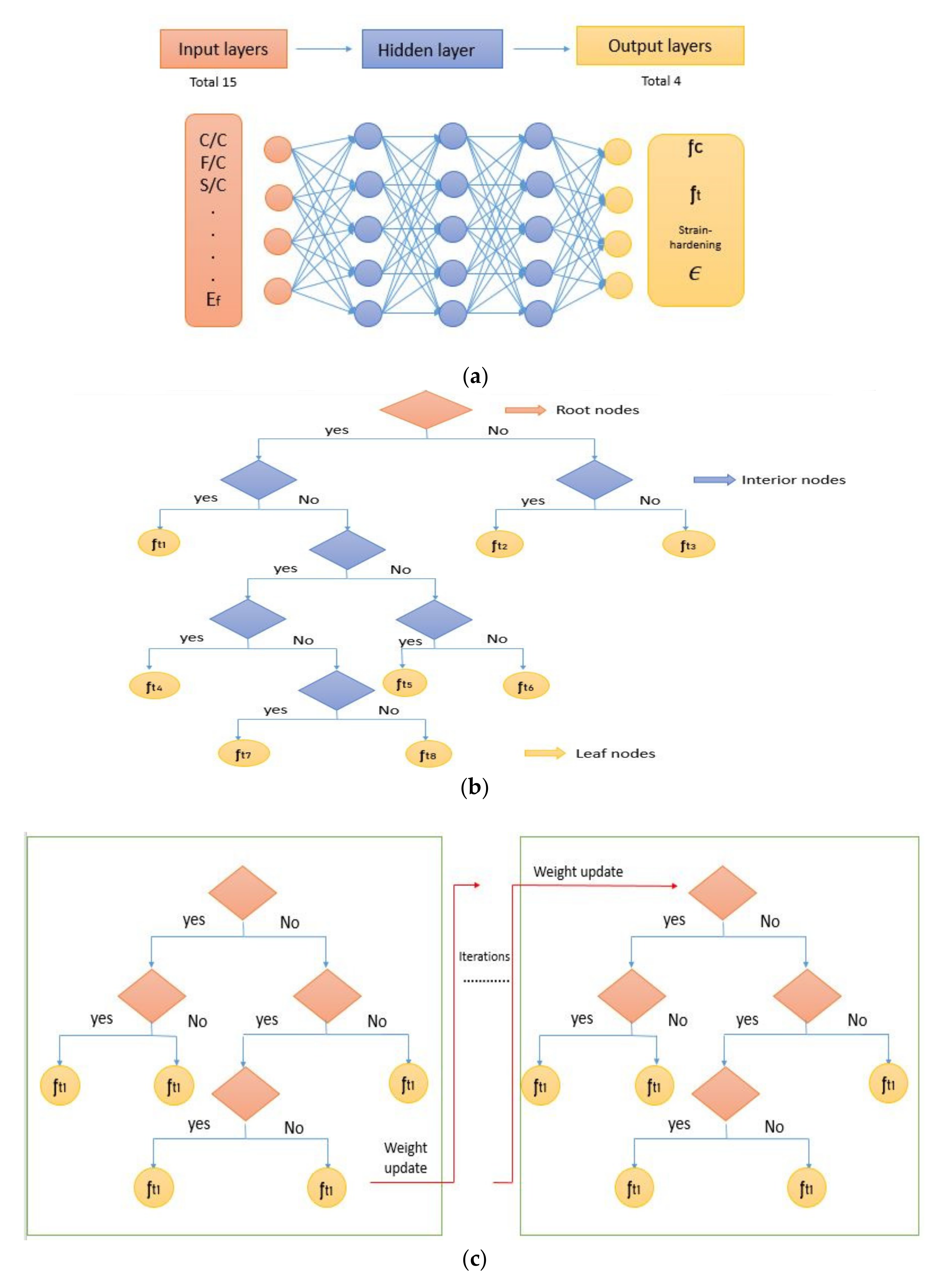




| No: | Input Variable | Range | Unit | Mean | Standard Deviation |
|---|---|---|---|---|---|
| 1 | Cement-to-cement ratio | 1 | 1 | 1 | 0 |
| 2 | Fly ash-to-cement ratio | 0–4.4 | 1 | 0.64 | 0.97 |
| 3 | Sand-to-cement ratio | 0–6.5 | 1 | 1.3 | 0.9 |
| 4 | Coarse aggregate-to-cement ratio | 0–7.24 | 1 | 1.15 | 1.53 |
| 5 | Limestone powder-to-cement ratio | 0–6.5 | 1 | 0.052 | 0.39 |
| 6 | Slag-to-cement ratio | 0–4 | 1 | 0.109 | 0.38 |
| 7 | Silica fume-to-cement ratio | 0–0.375 | 1 | 0.037 | 0.08 |
| 8 | Metakaolin-to-cement ratio | 0–0.5 | 1 | 0.011 | 0.05 |
| 9 | Fiber content | 0–7 | % | 1.59 | 0.89 |
| 10 | Water-to-binder ratio | 0.14–0.99 | 1 | 0.42 | 0.16 |
| 11 | Superplasticizer content. | 0–6 | % | 1.1 | 1.5 |
| 12 | Fiber length | 0–100 | mm | 16.7 | 12 |
| 13 | Fiber diameter | 0–1000 | µm | 176 | 259 |
| 14 | Fiber tensile strength | 0–4475 | MPa | 1476 | 800 |
| 15 | Fiber elastic modulus | 0–228 | GPa | 80.2 | 71 |
| Method | Hyperparameters | Range | Optimal Value for Different Parameters | |||
|---|---|---|---|---|---|---|
| Compressive Strength | Tensile Strength | Strain-Hardening | Tensile Strain Capacity | |||
| ANN | Hidden layer size | 1–100 | 55 | 64 | 65 | 68 |
| SVM | C | 1–20 | 10 | 6 | 12 | 9 |
| Gamma | 0.1–1 | 0.4 | 0.3 | 0.7 | 0.6 | |
| Epsilon | 0.1–2 | 0.1 | 0.1 | 0.1 | 0.1 | |
| CART | Maximum depth | 2–10 | 2 | 5 | 2 | 4 |
| Minimum samples leaf | 2–10 | 2 | 2 | 2 | 2 | |
| GPR | Kernel Scale | 0.001–1 | 0.024 | 0.034 | 0.028 | 0.022 |
| Sigma | 0.0001–254 | 0.0054 | 0.06 | 0.00326 | 0.00125 | |
| Compressive Strength | Tensile Strength |
|---|---|
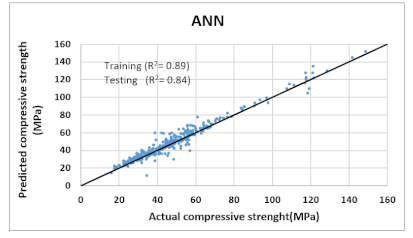 | 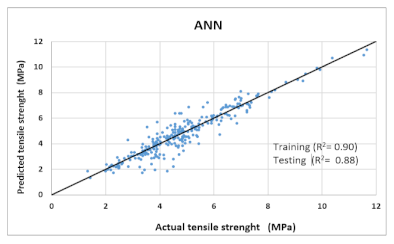 |
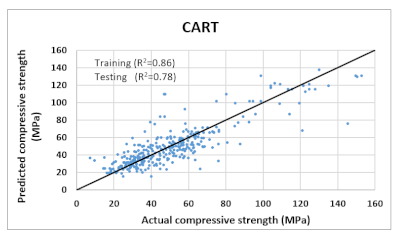 |  |
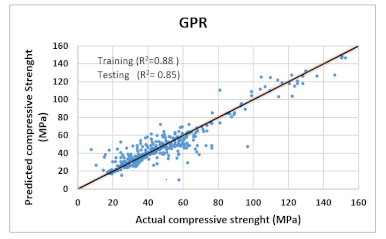 | 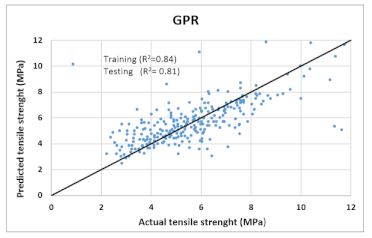 |
 | 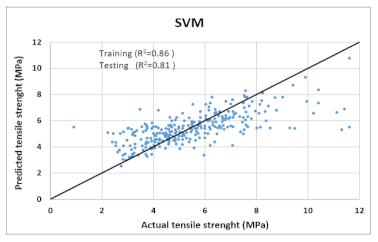 |
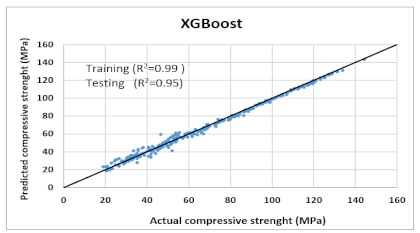 |  |
| Tensile Strain | |
|---|---|
 | |
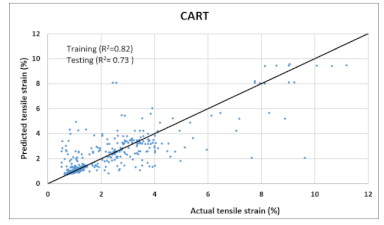 |  |
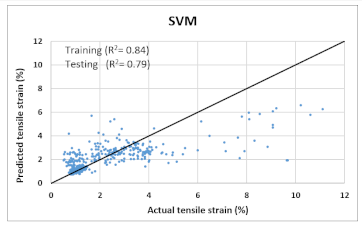 | 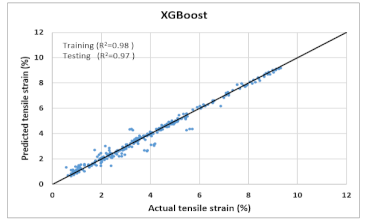 |
| Strain-Hardening | |
|---|---|
 |  |
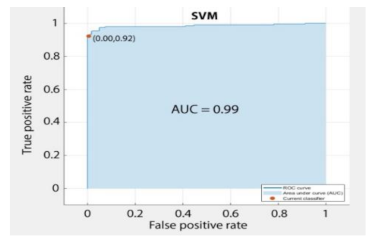 | 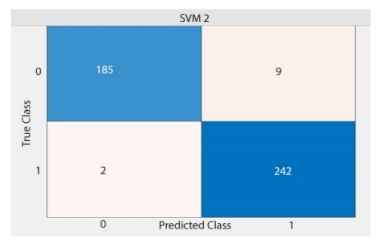 |
| Model | Set | Evaluation | Compressive Strength | Tensile Strength | Strain-Hardening | Tensile Strain Capacity |
|---|---|---|---|---|---|---|
| ANN | Training | RMSE | 5.7 | 0.7549 | - | 0.7189 |
| R2 | 0.893 | 0.902 | - | 0.899 | ||
| R | 0.94 | 0.941 | - | 0.93 | ||
| AUC | - | - | 0.98 | - | ||
| Accuracy | - | - | 96.3% | - | ||
| Testing | RMSE | 7.3 | 1.038 | - | 0.7726 | |
| R2 | 0.84 | 0.885 | - | 0.86 | ||
| R | 0.92 | 0.937 | - | 0.91 | ||
| AUC | - | - | 0.97 | - | ||
| Accuracy | - | - | 94% | - | ||
| SVM | Training | RMSE | 12.05 | 1.4 | - | 1.3 |
| R2 | 0.76 | 0.86 | - | 0.84 | ||
| R | 0.88 | 0.927 | - | 0.9 | ||
| AUC | - | - | 0.98 | - | ||
| Accuracy | - | - | 97.5% | - | ||
| Testing | RMSE | 12.49 | 1.8 | - | 1.44 | |
| R2 | 0.73 | 0.81 | - | 0.79 | ||
| R | 0.84 | 0.9 | - | 0.87 | ||
| AUC | - | - | 0.96 | - | ||
| Accuracy | - | - | 97% | - | ||
| CART | Training | RMSE | 6.025 | 1.8 | - | 1.1 |
| R2 | 0.868 | 0.83 | - | 0.82 | ||
| R | 0.91 | 0.9 | - | 0.89 | ||
| AUC | - | - | 0.98 | - | ||
| Accuracy | - | - | 94.67% | - | ||
| Testing | RMSE | 11.97 | 1.97 | - | 1.357 | |
| R2 | 0.78 | 0.74 | - | 0.73 | ||
| R | 0.87 | 0.855 | - | 0.85 | ||
| AUC | - | - | 0.95 | - | ||
| Accuracy | - | - | 93% | - | ||
| XGBoost | Training | RMSE | 1.59 | 0.2 | - | 0.163 |
| R2 | 0.99 | 0.983 | - | 0.98 | ||
| R | 0.995 | 0.9918 | - | 0.9927 | ||
| AUC | - | - | 0.998 | - | ||
| Accuracy | - | - | 98.5% | - | ||
| Testing | RMSE | 2.35 | 0.31 | - | 0.18 | |
| R2 | 0.95 | 0.95 | - | 0.974 | ||
| R | 0.97 | 0.97 | - | 0.991 | ||
| AUC | - | - | 0.99 | - | ||
| Accuracy | - | - | 98.4% | - | ||
| GPR | Training | RMSE | 8.6 | 1.1 | - | 1.007 |
| R2 | 0.88 | 0.84 | - | 0.69 | ||
| R | 0.92 | 0.89 | - | 0.81 | ||
| Testing | RMSE | 9.1 | 1.37 | - | 1.16 | |
| R2 | 0.85 | 0.81 | - | 0.67 | ||
| R | 0.89 | 0.86 | - | 0.8 |
Publisher’s Note: MDPI stays neutral with regard to jurisdictional claims in published maps and institutional affiliations. |
© 2021 by the authors. Licensee MDPI, Basel, Switzerland. This article is an open access article distributed under the terms and conditions of the Creative Commons Attribution (CC BY) license (https://creativecommons.org/licenses/by/4.0/).
Share and Cite
Khokhar, S.A.; Ahmed, T.; Khushnood, R.A.; Ali, S.M.; Shahnawaz. A Predictive Mimicker of Fracture Behavior in Fiber Reinforced Concrete Using Machine Learning. Materials 2021, 14, 7669. https://doi.org/10.3390/ma14247669
Khokhar SA, Ahmed T, Khushnood RA, Ali SM, Shahnawaz. A Predictive Mimicker of Fracture Behavior in Fiber Reinforced Concrete Using Machine Learning. Materials. 2021; 14(24):7669. https://doi.org/10.3390/ma14247669
Chicago/Turabian StyleKhokhar, Sikandar Ali, Touqeer Ahmed, Rao Arsalan Khushnood, Syed Muhammad Ali, and Shahnawaz. 2021. "A Predictive Mimicker of Fracture Behavior in Fiber Reinforced Concrete Using Machine Learning" Materials 14, no. 24: 7669. https://doi.org/10.3390/ma14247669
APA StyleKhokhar, S. A., Ahmed, T., Khushnood, R. A., Ali, S. M., & Shahnawaz. (2021). A Predictive Mimicker of Fracture Behavior in Fiber Reinforced Concrete Using Machine Learning. Materials, 14(24), 7669. https://doi.org/10.3390/ma14247669







